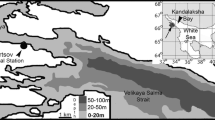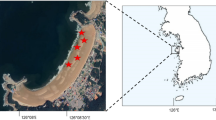Abstract
The leptomedusa, Mitrocoma cellularia, ranges from the Bering Sea to southern California and may be found year-round in the surface waters of Monterey Bay, California. These jellies are relatively long-lived, making them ideal hydromedusae for display at public aquaria. While M. cellularia are commonly found in Monterey Bay, it is not always possible to collect them due to foul weather and patchy distribution. To maintain a constant and reliable source of these medusae, a laboratory cultivation protocol was developed and implemented. The described life cycle of M. cellularia remained incomplete, lacking information regarding the benthic hydroid colony and early medusa. This paper reports descriptions for the hydroid colony and early medusa stages of M. cellularia based on specimens grown at the Monterey Bay Aquarium, California, and provides a brief description of the rearing methods used.






Similar content being viewed by others
References
Arai MN, Brinkmann-Voss A (1980) Hydromedusae of British Columbia and Puget Sound. Can Bull Fish Aquat Sci 204:1–192
Bierbach M, Hofmann DK (1973) Experimental studies on colony growth and on budding of medusae in the marine hydroid Eirene viridula. Helgol Wiss Meeresunters 25:63–84
Bullard SG, Hay ME (2002) Palatability of marine macro-holoplankton: nematocysts, nutritional quality, and chemistry as defenses against consumers. Limnol Oceanogr 47:1456–1467
Bullard SG, Lindquist NL, Hay ME (1999) Susceptibility of invertebrate larvae to predators: how common are post-capture larval defenses? Mar Ecol Prog Ser 191:153–161
Colin SP, Costello JH (2002) Morphology, swimming performance and propulsive mode for six co-occurring hydromedusae. J Exp Zool 205:427–437
Cornelius PFS (1995) North-west European thecate hydroids and their medusae. Synopses of the British fauna number 50. Linnean Society of London
Crowell S (1957) Differential responses of growth zones to nutritive level, age, and temperature in the colonial hydroid Campanularia. J Exp Zool 134:63–90
Edwards C (1973) The medusa Mitrocomella polydiademata and its hydroid. J Mar Biol Assoc UK 53:601–607
Gili JM, Hughes RG (1995) The ecology of marine benthic hydroids. Oceanogr Mar Biol Annu Rev 33:351–426
Johnsen S (2001) Hidden in plain sight: the ecology and physiology of organismal transparency. Biol Bull 201:301–318
Kramp PL (1968) The hydromedusae of the Pacific and Indian Oceans. Sections II and III. Dana-Rep 72:1–200
Mackie GO, Mackie GV (1963) Systematic and biological notes on living hydromedusae from Puget Sound. Natl Mus Can Bull 199:63–84
Miller RL (1979) Sperm chemotaxis in the hydromedusae. I. Species-specificity and sperm behavior. Mar Biol 53:99–114
Mills CE (1983) Vertical migration and diel activity patterns of hydromedusae: studies in a large tank. J Plankton Res 5:619–635
Mills CE (1993) Natural mortality in NE Pacific coastal hydromedusae: grazing predation, wound healing and senescence. Bull Mar Sci 53:194–203
Piraino S (1991) The adaptive pattern of growth and reproduction of the colonial hydroid Clavopsella michaeli. Hydrobiologia 216/217:229–234
Purcell JE, Mills CE (1988) The correlation between nematocyst types and diets in pelagic hydrozoa. In: Hessinger DA, Lenhoff HM (eds) The biology of nematocysts. Academic, pp 463–485
Raskoff KA (2001) The impact of el nino events on populations of mesopelagic hydromedusae. Hydrobiologia 451:121–129
Raskoff KA, Sommer FA, Hamner WM, Cross KM (2003) Collection and culture techniques for gelatinous zooplankton. Biol Bull 204:68–80
Stachowicz JJ, Lindquist N (2000) Hydroid defenses against predators: the importance of secondary metabolites vs. nematocysts. Oecologia 124:280–288
Stebbing ARD (1980) Increase in gonozooids frequency as an adaptive response to stress in Campanularia flexuosa. In: Tardent P, Tardent R (eds) Developmental and cellular biology of Coelenterates. Elsevier/North-Holland, Amsterdam, pp 27–32
Stebbing ARD (1982) Hormesis—the stimulation of growth by low levels of inhibitors. Sci Total Environ 22:213–224
Sund P (1954) The early development of certain Puget Sound hydromedusae. Zoology 533 class report, summer 1954. Friday Harbor Laboratories Library
Wrobel D, Mills CE (1998) Pacific coast pelagic invertebrates: a guide to the common gelatinous animals. Sea Challengers/Monterey Bay Aquarium, Monterey
Acknowledgements
I would like to thank two anonymous reviewers for their valuable comments and suggestions. I would also like to thank B. Upton, R. Kocevar, E. Seidel, K. Raskoff, C.J. Slager, G.I. Matsumoto and R. Hamilton for reviewing early drafts of this manuscript. I would also like to thank my family, A. Pereyra, P. Seekoei, T. Duncan, Teams Drifters and Jellies Living Art, J. Hoesch, J. Welsch, P. Pringle, J.R. Sosky, J. DeMartini, G. Brusca, Theta Epsilon, T. Hardy, M. Faulkner and D. Hutchinson for much-needed help during this project. I am also indebted to the Monterey Bay Aquarium, for laboratory space, boat time and materials. Finally I would like to thank the animals in this study that taught me so much; I will be forever grateful. The experiments conducted in this study comply with the current laws of the USA in which the experiments were performed.
Author information
Authors and Affiliations
Corresponding author
Additional information
Communicated by P.W. Sammarco, Chauvin
Rights and permissions
About this article
Cite this article
Widmer, C.L. The hydroid and early medusa stages of Mitrocoma cellularia (Hydrozoa, Mitrocomidae). Marine Biology 145, 315–321 (2004). https://doi.org/10.1007/s00227-004-1322-x
Received:
Accepted:
Published:
Issue Date:
DOI: https://doi.org/10.1007/s00227-004-1322-x




